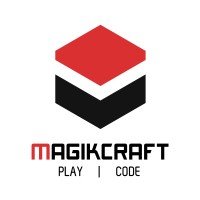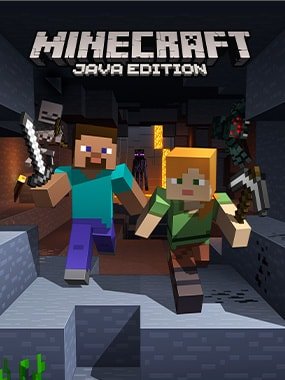Minecraft for Type 1 Diabetes (MC:T1) was a Minecraft minigame envisioned by java-coding startup Magikcraft.io as an educational-entertainment tool to teach kids about Type 1 Insulin-dependent Diabetes. The project received grant sponsorship from the Queensland University of Technology (QUT) faculty of Creative Industries.
Brought on as story developer and on-staff diabetes consultant, I was eventually promoted to assistant production manager, overseeing the assessment (scope and goals, educational content, game narrative) and rebuilding of the project to deliver a refined project brief and proof of concept prototype.
Introduction to Minecraft and Magikcraft
What is Minecraft?
Released in 2011, Minecraft is a popular three-dimensional fantasy sandbox game, coded using the computer programming language Java.
The game-world is composed of rough 3D cubes (commonly called “blocks”) representing various materials such as dirt, different types of stone, ores, wood, water and lava, as well as various plants and creatures/monsters (commonly called “mobs”) formed from blocky shapes. The game engine has a basic physics system that causes players, mobs, items and a small number of block-types to be affected by gravity, with players and mobs taking fall damage if they drop more than a certain distance.
Core Minecraft gameplay revolves around breaking blocks – some of which allow the broken block to be collected, while others drop items – and placing blocks to create structures, with a crafting system that allows blocks and items to be combined into increasingly complex new items/blocks. Minecraft is notable for its inclusion of a current-conducting material known as redstone, which can be used to construct primitive mechanical devices, electrical circuits, and logic gates, allowing players to build complex systems.
Game modes include survival mode (in which players must acquire resources to build in the world and maintain health) and a creative mode (in which players have unlimited resources and access to flight). In survival mode, the player is loaded into a procedurally-generated world of functionally infinite size, with terrain automatically created based on a map seed.
Players can choose to play in a single-player mode, or to compete/collaborate with other users on multi-player online servers.
Minecraft is produced by Mojang Studios, a subsidiary of Microsoft.
A user-built castle. Fenming Wang/Flickr, CC BY
About Magikcraft.io
Magikcraft is a Brisbane-based startup game company that aims to deliver educational minigames within Minecraft.
Why use Minecraft?
Popularity and large userbase, ranking within the top 10 computer games in 2016. (Minecraft would go on to sell over 283 million copies by 2023, becoming the best-selling videogame of all time.)
Accessible game-play and broad demographic appeal, being played by users of all ages and genders but especially school-age children.
Use in other educational projects and programs (read more at The Conversation).
Java-based game code can be easily modified, leading to a wide culture of fan-made “mods” and minigames.
Magikcraft’s primary project is a Minecraft-based minigame aimed at teaching children the basics of Java-coding.
The Original Pitch
The MC:T1 mingame was originally pitched as an action role-playing game in the style of popular fantasy titles such as The Elder Scrolls V: Skyrim, with a “Magical School” story-premise similar to Harry Potter.
The primary target audience was children who had recently been diagnosed with Type 1 Insulin Dependent Diabetes, intended to help young diabetics learn about key concepts for managing their condition.
The game would feature a series of modded-in “magic powers” alongside diabetes mechanics which controlled access to those powers depending on how well the player managed the character’s blood glucose level.
I was hired into the project mid-development, to assist with game-story development and provide consultation on the Diabetes mechanics.
Project Assessment: Game Story
The in-game story forms part of a game’s fictional narrative, providing motivation for the player character’s actions, justification for in-game events and emotional stakes to the obstacles and challenges.
Examples of videogame stories.
The in-game story also guides other aspects of the game narrative, such as the overall aesthetic, tone, pacing and gameplay progression arc.
Initial Brief
At the time of joining, the story was in a loose state, comprised of the following proposed concepts:
The game starts when the player is granted powers by a sudden lightning strike.
A magic-school story premise, similar to the company’s previous Harry Potter-inspired Minecraft educational coding game, Magikcraft.
Players would be teleported into the “magic school” setting and funneled through a series of basic tutorials to teach the diabetes mechanics.
The existing Minecraft Wither monster was proposed as the final boss, with the proposed motive of players needing to stop it from burrowing through and destroying the foundations of the game-world.
Gameplay concepts also included prototypes for an open-world setting where players could free-roam, finding their own adventures and playing the Minecraft base-game.
Story Challenge #1: Power Fantasies
The CEOs initially insisted that the game should be a “power fantasy”; pushing for the players to start off with a full suite of game powers and being resistant to the idea of starting the players in a disempowered or suboptimal position. They wanted to frame the game’s functional version of diabetes in a wholly positive light, to counteract a recently diagnosed players negative real-world experience.
Potential Problems
1. Emotional Honesty
Being diagnosed with diabetes can be an upsetting experience with a challenging period of adjustment. Attempting to ignore this with a story that treated it as purely positive risked coming across as condescending or emotionally invalidating to newly-diagnosed players, potentially alienating them from the game.
2. Balancing Gameplay
Gameplay challenges need to provide a certain level of difficulty in order to be mentally engaging. If the player starts off too powerful, it becomes difficult to design engaging challenges. It also makes it harder to design around the risk of players using certain abilities to bypass challenges entirely.
3. Satisfying Progression and Stakes
For many games, part of a rewarding sensation for players is the sense of achievement that comes from building the skills, knowledge, powers and/or tools to overcome escalating challenges. In a gameplay setting, the typical power fantasy is about becoming strong rather than starting off powerful enough to effortlessly overcome obstacles.
“Kids play games, not because they are easy, but because they are hard. They persist because they feel the reward of having achieved something that was a challenge.”
Many games start the player in a weak or disempowered state, with a goal of “leveling up”.
Challenge #2: Directing the Player
In the initial tutorial and gameplay prototypes, it was possible for players to leave the custom-created gameplay space and wander out into the wider, procedurally-generated Minecraft world. This introduced a risk that the players would choose to leave the designed game in favour of playing standard Minecraft with the addition of the power system.
A strong narrative and area design would be needed to steer players through the planned game.
Challenge #3: Creating Cohesion
There was a broader lack of focus around the design of the game. At the time of joining, the game was still in early-production, with many test-concepts but limited cohesion or clear direction.
In order to design a story that served the aesthetic, tone and educational goals of the game, a more focused and measurable overall project brief was required.
Before telling the in-game story, we needed to develop a clear story for the goals, direction and future of the project.
Project Assessment: Scope & Goals
To assist with developing a refined brief, a number of project components were assessed:
Team scope vs project proposal
An early consideration was assessing whether the proposed pitch and project scope were achievable by the project team.
Triple A (AAA) Games are high production-value projects, with large budgets, development teams and long production cycles, usually backed by large first-party studios and publishers.
Double-A (AA) Games are mid-market projects, typically backed by a publisher and with some professional development, but a smaller overall scope.
Independent (Indie) Games are produced by individuals or small development teams without the financial and technical support of a large game publisher. They are typically defined by small project scopes and high experimental freedom.
As a small startup-up operating a mostly part-time team, backed by a small grant from QUT, Magikcraft and MC:T1 fell within the scope of an ‘Indie’ developer.
At the time I joined the project, the MC:T1 Team was less than one year from the end of QUT grant support and delivery deadlines.
Bethesda’s AAA Open World RPG Skyrim had a 100-person team and six-year production timeline.
The original Minecraft was an indie game with a two-person team and two years of pre-launch development.
The refined brief needed to be achievable within the available work hours, resources and remaining time-frame of a part-time independent game developer with an approaching deadline. This would be the primary constraint when considering the complexity and total scale of the revised pitch.
Minecraft as an engine: limitations
Using an existing game as the base for a minigame bypasses a number of production steps by providing a pre-built game system with already-tested assets, animations and other elements. However, it also places limitations on the project based on the capabilities of the original game.
Any change to the Minecraft base-game requires the implementation of bespoke coding by the MC:T1 development Team.
The more MC:T1 deviates from Minecraft, the more work is required from programming staff, increasing the production time and salary costs.
The more additions and changes are made to the base code, the higher the risk that the modded minigame could become unstable, lag-prone or even crash due to increased memory draw and/or conflicting commands.
Common player-actions in Survival Mode:
Movement (forward, back, left, right, sprint, sneak, jump, climb, swim)
Breaking and placing blocks
Interacting with buttons, switches, containers and books
Attacks (single weapon-strike, firing a bow, throwing projectiles)
Opening the trading and crafting interfaces
Steering rowboats and saddled mobs
Riding in minecarts
The game also contains a series of codes to spawn or despawn various passive, neutral or hostile mobs depending on gameplay conditions, as well as rudimentary artificial intelligence systems directing how mobs move, behave and respond to the player in real-time.
Unlike more complex software engines (such as Unreal or Unity) commonly used in the creation of RPG videogames, the Minecraft base-game does not come with the system architecture needed to implement connecting questlines, quest-triggers, quest-logs, dialogue trees, branching choices or scripted story scenes.
While additional systems could be modded into the game, each addition would increase the required workload and project scope.
Attempting to implement too many additional systems could take the game beyond the achieveable scope of the project. It could also reach a point of diminishing returns, where the workload required to implement systems not present in the base game exceeded the workload saved by using an existing game.
Building an action RPG within Minecraft was likely to be out of scope for the MC:T1 team.
To avoid generating excessive work and project scope expansions, the refined pitch would need to target game builds and gameplay genres that could be assembled as much as possible with the Minecraft base-game’s existing systems and assets.
Limitations to storytelling
Minecraft’s sandbox base game offers limited support for text-based communication:
Small parcels of text can be stored and delivered through wooden signs and written-book items.
No speech bubbles or other dialogue boxes are present.
Players on multiplayer servers have access to a limited chat function for player-to-player communication.
While hovering text-blocks can be modded into the game for simple communication, these often look visually incongruous within the game world.
Minecraft does not have systems for spoken communication:
The base game does not have distinct non-player characters, instead using a basic villager mob.
Game entities communicate entirely with nonverbal vocalisations (grunts, hums, clicks, chirps etc).
No recorded speech-lines or spoken conversations are present within the game.
Working within these limitations, the revised game-story and educational content would need to be designed with consideration for minimising large volumes of text-based exposition or dialogue.
Educational goals and possible game types
Teaching children about Type 1 Diabetes is a broad goal, with many potential facets and learning areas.
Emotional preparedness: Exploring the emotional experience of adjusting to and living with Type 1 diabetes.
Medical theory: Understanding the biology and endocrinology behind type 1 diabetes.
Conceptual understanding: Understanding the interactions between key concepts in diabetes management.
Practical habits: Helping players develop lifestyle routines and daily practices for monitoring and management.
Based on Minecraft’s strengths/limitations as a teaching platform and the direction of initial MC:T1 development proposals, a conceptual game aimed at exploring how lifestyle factors and medication impacted blood glucose management in Type 1 Diabetes was assessed as the best fit for the project.
Project Assessment: Educational Content
Introduction to Type 1 (Insulin Dependent) Diabetes
Type 1 Diabetes (also known as Diabetes Mellitus Type 1 or Insulin-dependent Diabetes) is a chronic endocrine condition that affects the regulation of blood sugar. The condition is caused by an autoimmune reaction, where the body’s immune system attacks and destroys the insulin-producing β-cells of the pancreas.
Insulin is the principal hormone governing the uptake and metabolism of glucose (sugar) from the bloodstream following digestion. Without insulin, glucose is not absorbed by the cells, leading to excessively high blood glucose levels (BGLs) – a condition known as hyperglycaemia.
Chronic hyperglycaemia can result in a variety of serious complications including (but not limited to) damage to the kidneys, nerves, cardiovascular system, retinas and extremities, stunted growth, increased risks of infection and gastrointestinal complications. Lack of insulin can also progress to diabetic ketoacidosis – a potentially life-threatening complication caused by the body metabolising fatty acids and amino acids for energy in the absence of glucose uptake by the cells, turning the blood acidic.
Management
Type 1 Diabetes is treated through regular dosing with insulin to combat hyperglycaemia. Insulin is delivered through subcutaneous injection via syringes, insulin pens or insulin pumps. Diabetics monitor blood glucose via glucose meters or a continuous glucose monitor, administering multiple injections per day with doses adjusted to account for food intake, BGLs and physical activity. The goal of treatment is to maintain blood sugar in a normal range.
A risk that must be managed with this treatment is the potential for hypoglycaemia (low blood glucose). Hypoglycaemia typically results from excessive or poorly-timed insulin dosing. As insulin triggers glucose absorption and supresses the release of glucose into the bloodstream, an excess of insulin can cause blood glucose levels to fall dangerously. Hypoglycaemia can be potentially life-threatening if allowed to progress unchecked.
A duty of care
As primary purpose of MC:T1 was to act as a teaching tool for understanding and management of a real-life health condition, the depiction of diabetes concepts needed to be as accurate and authentic as possible within the restrictions of the game system.
Considering the potentially severe risks associated with diabetes mismanagement, the development team could not afford to make changes to the diabetes mechanics where those changes risked potentially misinforming players in ways that could be detrimental to their real life diet, exercise and blood glucose management choices, even if the changes would otherwise improve gameplay balance or player fun.
Adapting for games: reasonable abstractions
Type 1 Diabetes is a complex condition, whose symptoms, management and long-term effects can vary between individuals. Creating a comprehensive simulation of Diabetes within Minecraft’s engine would require development and implementation of bespoke health modelling and gameplay systems which would be out of scope for the project.
Instead, MC:T1 aimed to present an abstracted representation of Type 1 Diabetes, communicating key concepts for blood glucose management in a simplified form that could be easily understood by younger players and implemented using existing game assets where possible.
Although simplified, it was still critical that the proposed game mechanics represented the corresponding diabetes concepts as accurately as possible.
Evaluation of MC:T1’s initial diabetes mechanics
Blood Glucose
Food & Digestion
Exercise
Initial Assessment: Conclusions
Developing a Refined Brief
Establish Game Priorities
Research into Play Types
Development of Story
Revised Project Pitch
New Game Build & Refinement
Preparation for Consumer Trials
Delivery
On 13 May 2018 the MC:T1 team delivered a 5-level proof of concept prototype for use in consumer play-tests.
Report to Grant Sponsors
A report on the game development process and play-test feedback was produced for funding partners at Queensland University of Technology’s Creative Industry’s faculty.
Reflections & Future Challenges
Reflections on the project
The importance of clear project plans
Expectation management
Player freedom and choice in games
Next Steps
Feedback from initial play-test
Mechanical fine-tuning. Some play-testers initially struggled to with intuitively understanding the diabetes mechanics during gameplay, leading to misconceptions about the relationship between food and insulin. Refining the digestion, insulin and blood glucose mechanics to make them more responsive to player inputs may improve clarity.
Greater story signposting. Play-tests revealed that players tended to skip the “mentor journal” tutorial books placed in the game-world to clarify mechanics and story-goals. Better placement and visual signposting of key story locations, and/or further refinement of play mechanics to help players intuit information without overt written instruction may help to alleviate these issues.
Further consumer trials
The initial play test showed promising outcomes towards the current prototype’s goals of teaching children to understand diabetes management concepts. Further consumer trials with larger player bases (including a larger number of non-diabetic players) would help to refine MC:T1’s educational content delivery and play-experience ahead of proceeding to later level builds.
Future Challenges
Version Control
Modern Minecraft is a Live Service Game, with development teams at Mojang Studios frequently rolling out updates which introduce additional content, mechanics and/or patch issues. MC:T1 was developed as a variant of the Minecraft Java 1.08 edition. As of July 2023, the current active version of the game is the Minecraft Java 1.20.1 edition.
As the addition of new food items and player actions in updated editions will have flow on impacts for MC:T1’s food, insulin and exercise mechanics, the project will need to find away to account for changes. Possible options include:
Employ a continuous staff team to implement code updates, keeping pace with new editions of the base game. This would keep the game accessible to the highest number of potential new players but would generate ongoing salary expenses.
Convert the MC:T1 game server to a legacy server locked at the Java 1.8 edition to avoid new updates. This would avoid the need to keep pace with updates, at the cost of limiting accessibility and appeal to players using newer editions.
Promotional Art for the 1.20 Trails & Tales Edition
Complicating things further, in 2016 Mojang Studios released a multi-platform version of Minecraft, created in a new “bedrock engine” using the C++ programming language to run on platforms that could not support Java (such as videogame consoles or mobile phones). The original Java-based Minecraft (now renamed “Java Edition”) and new C++-based Minecraft (designated “Bedrock Edition”) do not have directly compatible code and cannot share servers.
It appears that Mojang is pivoting towards Bedrock becoming the major version of the game, with the Bedrock Edition being sold as the default version of Minecraft on most platforms (including Windows 10), receiving new updates faster, being used as the base variant for the Education, Dungeons, Legends and other variants, and hosting the Minecraft Marketplace store.
The original Minecraft is now sold as “Java Edition”.
The multi-platform “Bedrock Edition” is now the default base for other variants and the marketplace store.
While the “Java Edition” is still supported, and remains popular with parts of the community for its easily-modified code, the pivot towards Bedrock Edition is likely to draw users away from accessing the Java-based MC:T1 minigame. In order to take advantage of the Bedrock Edition, a second bespoke version of MC:T1 would need to be built for the C++ Bedrock Engine - something that may be out of scope for the project depending on the cost and time needed to train relevant team members in a new programming language.
Version control, both for edition updates and multi-platform variants, will likely present one of the largest challenges to the long-term viability of the MC:T1 project.
Licensing Considerations
Unlike fully-original indie games, MC:T1’s status as a Minecraft minigame introduces additional licensing considerations to marketing strategies and models for revenue.
While Magikcraft may have copyright over bespoke systems and game mechanics created specifically for MC:T1, the original Minecraft game systems, assets and branding are held under copyright by Mojang Studios and their parent-company Microsoft.
Minecraft’s brand usage guidelines do not allow unaffiliated products or services to use the name Minecraft as part of their primary name or title unless granted specific permission. As a result, the project’s current working title, Minecraft for Type 1 Diabetes, will need to be reworked into a compliant form ahead of any official launches.
Microsoft and Mojang have been generally supportive of player communities creating and releasing free minigames and assets. In 2021, Mojang released an officially supported modification Add-On system for the Bedrock version.
Minecraft’s usage guidelines also place restrictions on the methods and extent to which unaffiliated creators can profit from service-fees, sales or advertising on Minecraft-associated products. Magikcraft will need to factor compliance with commercial usage guidelines into all planned revenue models.
Magikcraft may benefit from directly engaging with Mojang/Microsoft to create a formal licensing agreement if they wish to take the project large-scale.
The Microsoft Partner Program has allowed partnered users to develop and sell approved content on the Bedrock-compatible Minecraft Marketplace since 2017.




































